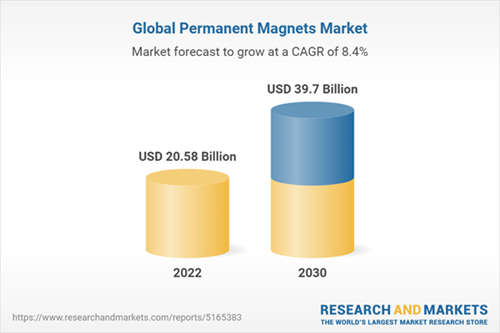By Stan Trout, Spontaneous Materials
A little over five years ago I wrote a column called Dysprosium 2.0. Element number 66 has been in focus lately due to some forecasts about availability in light of some new applications. Adamas predicts a 30% shortage of Dy by 2025. It seems like an appropriate time to look at the situation again.
The final conclusion of the Adamas report is, If automakers, motor manufacturers, and other end-users of high-temperature NdFeB do not act today to secure long-term supplies, they will soon find themselves amidst a sellers market scrambling for rare earth motor metals the same way many are scrambling today for battery metals.
Well come back to this point later.
Just as a refresher, the four eras I defined previously to describe the use of dysprosium in NdFeB magnets are as follows:
1.0 The initial discovery that Dy can increase the HcJ of NdFeB magnets, which in turn allows higher operating temperatures. This happened very early, circa 1983.
1.1 The realization that other alloying elements such as niobium and cobalt can reduce, but not eliminate, the need for Dy. We also learned that terbium works a bit better than Dy in increasing HcJ, but Tb is usually not as cost effective. This was 1990 to about 2005.
1.2 The development of Grain Boundary Diffusion (GBD) technology. This technology puts dysprosium preferentially in the grain boundaries and their adjoining regions, not throughout the alloy, as was the original practice. It achieves the same effect, i.e. increased HcJ, with roughly 50% less Dy. This technology has been in use since approximately 2005.
2.0 A combined strategy based on the following five significant features:
- A search for more resources;
- Increased interest in recycling;
- Widespread application of Dy reduction technology, i.e. Dysprosium 1.2;
- A search for new magnets without Dy;
and
- Designs minimizing the use of Dy
Dysprosium 2.0 has been going on since about 2010.
Here is an update on the five Dysprosium 2.0 strategies:
- Additional resources have been located, but since prices for rare earths have been relatively low for the past few years, investment in these projects has been minimal. The important point is we have better knowledge about the location of potentially viable deposits. Activity would likely return as soon as Dy prices climb.
- Recycling activities are taking place on a limited scale. In other words, we have started, but we still have a way to go to reach sustainability.
- Today many magnet companies offer GBD grades of NdFeB. There are many patents on the various ways to put Dy preferentially in the grain boundaries of NdFeB magnets. In my experience, they all seem to work. Because some extra processing is involved, there is a small price premium to GBD grades. This has caused some users to either delay qualification or implementation of designs using GBD grades. But my impression is that this is a change which could be done quickly, if warranted.
- Research in finding magnets without Dy has moved forward in several directions, such as substituting other rare earths, FeN materials and even new ferrite compositions have appeared. While some of these projects show promise, none has displaced Dy-containing grades of NdFeB.
- Even though it may not be considered as sexy as the other options, there has been good progress on the design front. Common approaches include optimizing designs to use less Dy, lowering the maximum temperature of the design (a special thanks to everyone who took my advice on this topic), using a combination of the two, or even engineering a SmCo or ferrite-based alternative design.
So should we be afraid of a looming dysprosium shortage? I am not as worried as the folks at Adamas. Let me explain why.
Recently I watched the documentary film Saving the Great Swamp, Battle to Defeat the Jetport. It details the struggle between the Port Authority of New York & New Jersey (PANYNJ) and an ad hoc group of environmentalists over a plan to build a jetport in a large wetland area located in Morris County, New Jersey. (This occurred between 1959-1968. Spoiler alert: the environmentalists won, and the wetlands are now known as the Great Swamp National Wildlife Refuge.)
One thing that jumped out at me was a small comment near the end of the film. Before suggesting that a jetport should be built, the PANYNJ commissioned a study of air travel patterns in the region. It concluded that there would soon be an insufficient number of gates in the New York City region to handle all the passengers and that a new airport was needed to alleviate this problem. These conclusions were the basis for their justification of the project.
However, buried deep within the report were the assumptions. One assumption was that the number of passengers per plane would remain relatively constant. Anyone who has flown commercially for the last few decades knows this isnt true. Aircraft today hold several times more passengers than the planes of the 1960s. The Jetport was predicated on an erroneous assumption; it was never needed.
Do we have a faulty assumption with dysprosium? Most forecasts I have seen usually look at the effect of one variable. They assume that everything else remains essentially constant. In the case of dysprosium, we have already seen that when prices go up, people make a wide variety of adjustments. Taken together, these adjustments tend to partially offset the higher price of Dy, and therefore have a moderating effect. It seems reasonable to assume that this behavior would happen again.
The time to become nervous about price and availability is when things change rapidly. Then no one in the supply chain has enough time to make any adjustments. But today we have a few extra things tucked in our back pocket that we can use to buck any price increases.
Beyond the advice from Adamas about hedging supplies of dysprosium, perhaps the best hedge for Dy may be a backup design in samarium cobalt that avoids dysprosium completely, or even a ferrite design. Of course, an immediate concern arises about having enough cobalt, and to a lesser extent samarium. This makes a good case for being prepared for any possibility, which is the nature of all good business and engineering.
So while we have made good progress on the issues surrounding dysprosium in the past five years, more work remains to be done.
SRT
June 18, 2018



